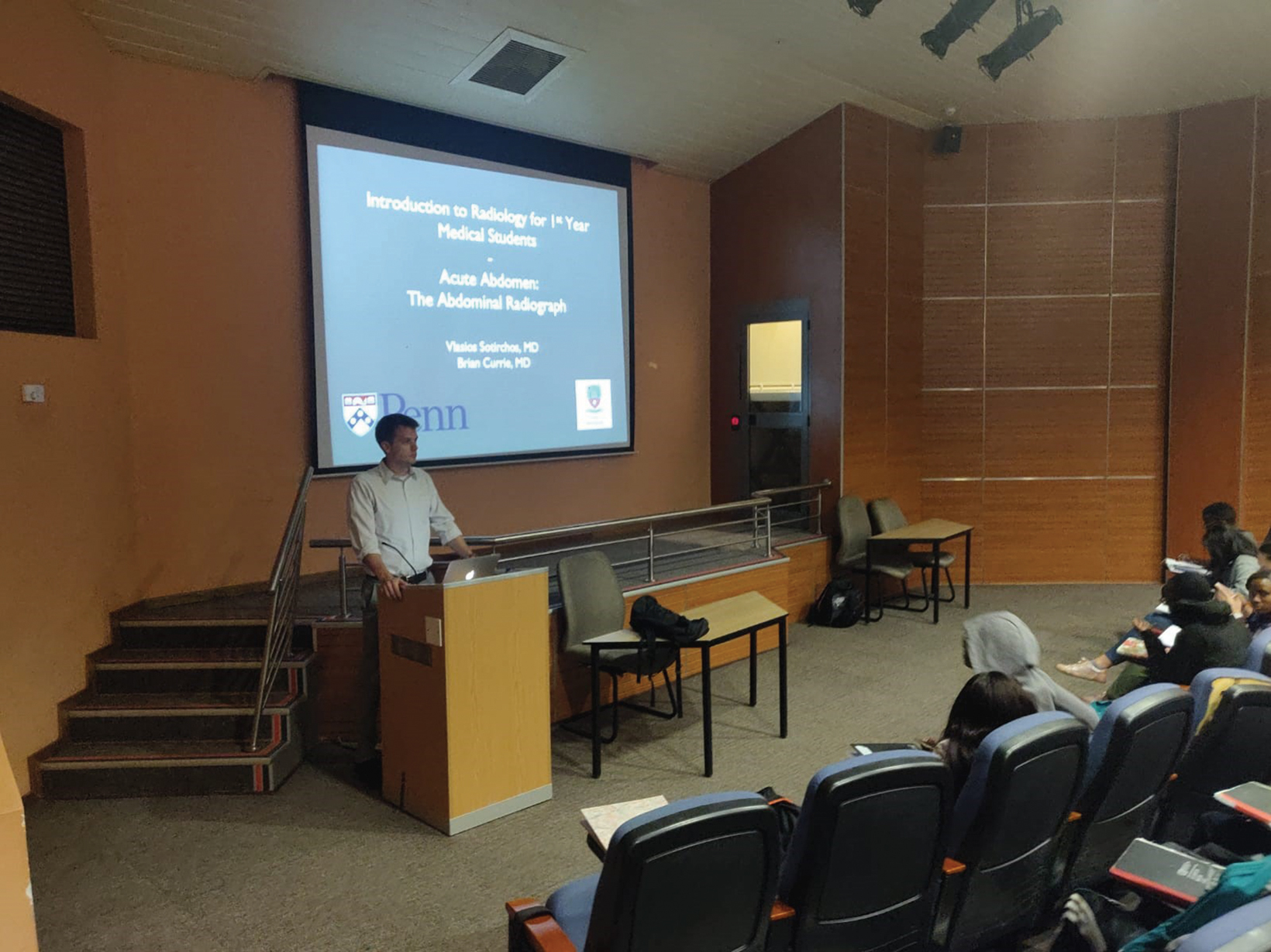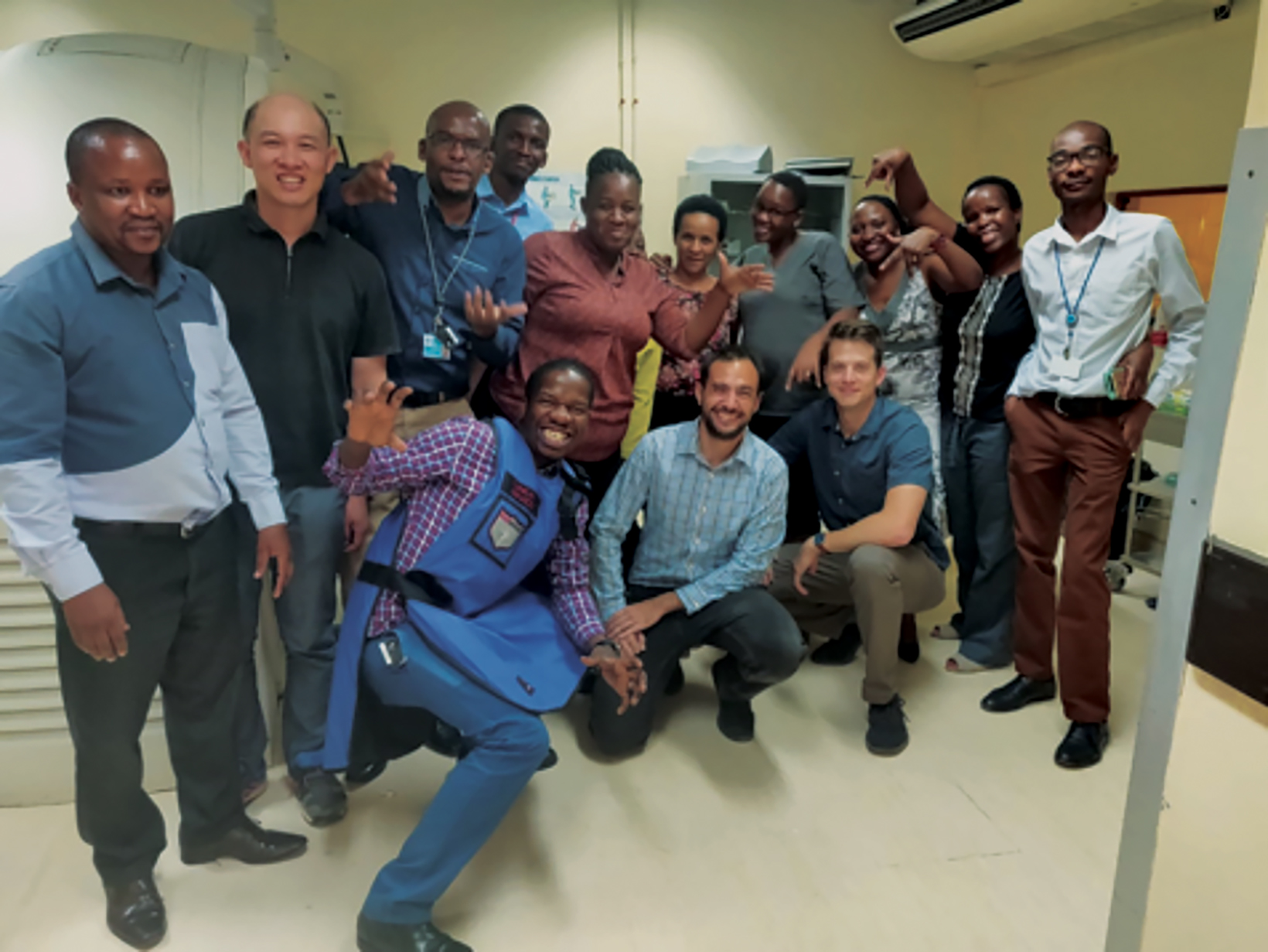Training Radiologists for Global Service
Images



Growing interest among US-based radiology trainees for a broader health experience has led many residency programs to add global health electives to their offerings.1,2 The field’s professional societies are also expanding their opportunities for involvement in worldwide health initiatives. These trends have led to a variety of options, particularly those relating to remote educational experiences.
Owing to the intricate incorporation of information technology into its workflows, radiology is in a unique position to benefit from the proliferation of internet access throughout the world. Fundamental components of education, such as didactic lectures, clinical case interpretation, and implementation projects can be performed remotely at a high level. Although remote interactions should not replace in-person visits, they can complement them and allow for continuous engagement with international partners, even during times of limited travel.
Global health education in radiology is still in the early stages of adoption, and it requires stakeholder collaboration and strong leadership to achieve a strong and sustained presence in residency programs.
Integration of International Rotations
The Accreditation Council for Graduate Medical Education (ACGME) provides guidelines for international elective rotations, recommending that they should be created by program directors in consultation with their graduate medical education committees and designated institutional officials.3 RAD-AID International offers a guide for creating an international elective that includes important components, such as finding an international partner and creating a curriculum.4
Moreover, information regarding global health training is appearing more and more frequently on residency program websites and publications, revealing their training focus and types of international partnerships. International partnerships can be developed through personal connections, collaboration with other organizations, or by leveraging existing institutional partnerships. Their area and scope of focus is often determined by partner site needs, available resources, and trainee interests.
A global health elective may include time devoted to focusing on implementation projects; eg, PACS, tumor boards; creation and delivery of educational content, and/or participation in clinical care. Trainees should expect to participate in multiple program components and be prepared to adapt to unforeseen events — an essential aspect of global health education.
Creating a Radiology Global Health Track
The global health experience offered by radiology residency programs has evolved over time, ranging from participation in oneto two-week outreach trips to lowand middle-income countries (LMIC), to enrollment in longitudinal programs supning several years of residency and culminating in spending weeks or even months on educational, clinical, and research activities in LMICs.5
As more of these opportunities become available, collaboration is needed among stakeholder organizations to establish core competency requirements, ethical considerations, and safety guidance. Part of this process is defining the components of education in global health and whether it should focus solely on LMICs or include all low-resource regions, including those in the US. A prerequisite to these efforts is defining global health radiology and outlining its scope; ie, whether it should be viewed as the spread of radiology into low-resource regions and/or a developing subspecialty of radiology itself — similar to the evolution of imaging informatics. Creating a global health track requires envisioning job opportunities for graduate trainees and ensuring that our departments and profession reflect them.
Leveraging Institutional Partnerships
An example of a global health elective is one in the Department of Radiology at the University of Pennsylvania, which builds on the existing Botswana-UPenn Partnership (BUP) and allows radiology residents to complete a fourto six-week clinical rotation at Princess Marina Hospital in Gaborone, Botswana.6
The University of Pennsylvania’s Perelman School of Medicine’s involvement in Botswana began in 2001 at the request of the African Comprehensive HIV/AIDS Partnership, and it has evolved into a collaboration with Botswana’s Ministry of Health and Wellness and the University of Botswana to improve clinical care, research, and medical education.7 The BUP has residency programs in internal medicine, pediatrics, anesthesiology, emergency medicine, family medicine, and pathology.8 Collaboration with these programs is an essential part of the Penn Radiology global health elective experience.
The BUP employs approximately 120 full-time staff in Botswana, including US-trained physicians.9 The partnership provides a process for Penn Radiology trainees to obtain a medical license in Botswana. In addition, flight expenses and in-country transportation and lodging are covered by BUP. Prior to travel, residents must complete a global health equities seminar offered through UPenn’s department of internal medicine, and obtain a certificate of proficiency in global health radiology from RAD-AID to improve sociocultural competence. Residents are also given the option to return to Princess Marina Hospital as fellows for up to six more weeks of additional training.
Our global health radiology clinical rotation objectives are presented in the context of six core competencies endorsed by ACGME and the American Board of Medical Specialties (Table).10
Conclusion
A growing number of global health electives and longitudinal training opportunities are being offered by radiology residency programs. Experiences like these that build on strong institutional partnerships provide for robust educational experiences and sustainable training programs.
References
- Haver HL, Rosen MP, DeBenedectis CM. Global radiology training prevalence among radiology residency programs. Current Prob Diagn Radiol. 2021;50(2):141-146.
- England RW, Lugossy AM, Mollura DJ. Increasing opportunities for trainees to engage in global health radiology: radiology in training. Radiology. 2021; 210371.
- “420_Guidelines_for_IntlRotations_in_DiagRad.pdf.” n.d. https://www.acgme.org/globalassets/PFAssets/ProgramResources/420_Guidelines_for_Intl Rotations_in_DiagRad. pdf. Accessed October 28, 2021.
- >Escalon JG, Renjen P. A step-by-step guide to creating an elective rotation abroad for radiology residents. [cited 30 Oct 2021]. Available at: https://rad-aid.org/wp-content/ uploads/Guide-to-Creating-an-Elective-Rotation-Abroad-for-Radiology-Residents.pdf
- Pool KL, Culp MP, Mollura DJ, Suh R. A structured global health training program for radiology residents. JACR J Am Coll Radiol. 2018;15(2):334-339.
- Health Equity Leadership Track. (n.d.). Retrieved October 30, 2021, from https://www.pennmedicine.org/departments-and-centers/department-of-radiology/education-andtraining/residency-programs/special-resident-programs/health-equity-leadership
- Cohn J, Friedman HM. Sustainable international partnership building for academic medical centers: experiences with the Botswana-UPenn Partnership. Virtual Mentor. 2010;12(3):179-183.
- Home. (n.d.). Retrieved October 30, 2021, from https://www.med.upenn.edu/botswana/
- >Mokone GG, Kebaetse M, Wright J, et al. Establishing a new medical school: Botswana’s experience. Acad Med. 2014;89(8 Suppl):S83-S87. doi:10.1097/ ACM.0000000000000329.
- The Milestone Guidebook. Accreditation Council for Graduate Medical Education. 2020. Available at: https://www.acgme.org/globalassets/milestonesguidebook.pdf. Accessed October 28, 2021.
References
Citation
F D, A N, L G, M S.Training Radiologists for Global Service. Appl Radiol. 2022; (1):34-36.
January 6, 2022